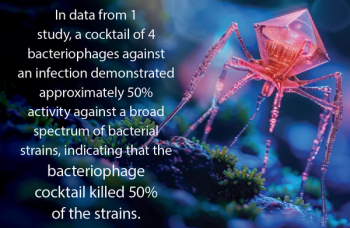
Meet our 2003 Educator of the Year
Meet our 2003 Educator of the Year
By Kelly M. Pyrek
Independent infection controlconsultant Linda L. Spaulding, RN, CIC, likens her job to that of a detective,tracking down the clues that will help her solve a client's contagiousconundrum. As Infection Control Today magazine's 2003 Educator of theYear, Spaulding demonstrates her ability to answer the questions of who, what,when, where and why of an infectious outbreak and to solve the mystery.Sometimes the revelation doesn't come until the very end of the case, but that'spart of the investigative chase.
"It's quite an adventure to never really know the ending until all theclues are in," she says. "Each case is different, adding to yourdetective knowledge base. The more you learn the faster you are able to answerthe 5Ws."
As owner of InCo & Associates, founded in 1994 and based in Waipahu,Hawaii, Spaulding provides extensive consultation and education in infectioncontrol issues such as employee health, total quality improvement specific toinfection control, compliance with state and federal regulations, training forfacility inspection by the health department, Joint Commission on theAccreditation of Healthcare Organizations (JCAHO) and the Occupational Safetyand Health Administration (OSHA), as well as lecturing on a variety of topicssuch as resistant organisms, surveillance, TB, latex allergies, hepatitis,bloodborne pathogens and isolation protocol. But one of her favorite services isoutbreak investigation, where she confirms the outbreak, identifies theetiology, collects data, implements and evaluates control measures and presentsher findings and recommendations to clients. Her hit-list of outbreak offendersreads like a microbiology textbook: vancomycin-resistant enterococcus (VRE),methicillin-resistant Staphylococcus aureus (MRSA), influenza andscabies, but one of her most interesting foes was the Norwalk Virus, which shesays is normally not seen in Hawaii and was only one of three such outbreaks inthe state's history.
"The facility reported five cases of patients presenting with diarrhea,nausea and vomiting, with all patients located on one unit," she recalls."Staff also became ill with the same symptoms. I asked the facility toimplement contact precautions for all patients with the addition of the staffusing masks. I could not understand if the staff was following standardprecautions, why they were coming down with the same symptoms. After meetingwith management we started to think foodborne illness so I went through thekitchen but came up empty. The decision was made not to float staff to that unitand not to admit any new patients. After obtaining stool cultures and reviewingthe literature the only thing that made sense was Norwalk-like Virus. Thecultures confirmed this diagnosis five days later. The staff became ill becausethey didn't think they had to wear a mask; they thought standard precautionsshould have been enough. What the staff did not understand was that withNorwalk-like Virus, when you change the bed sheets the virus becomes airborne,and the staff became ill because they did not wear masks. It is thought avisitor brought in contaminated food for a loved one. That one resident becameill and because it became airborne, a total of about 20 patients and six staffwere affected."
Spaulding also has learned that even outbreaks of the most routine virus canpose significant challenges.
"I was called to a facility because it had residents with high feversand cold symptoms, and four residents were very sick. I arrived at the facilityat 11 a.m., just two hours after the call, and the number of sick patients wasnow 12. I suspected it was a viral infection (possibly influenza) due to thefast transmission throughout the facility. Bacterial infections take a few daysto a week to spread, and it was obvious this illness was spreading withinminutes to hours. By 3 p.m., we had 42 sick residents. We immediately stoppedall visitors from entering the facility, all staff was required to wear masksand all admissions were put on hold. The department of health (DOH) requested wedo influenza cultures. Because the illness was so severe and spreading sorapidly I was concerned we were dealing with something we had not seenbefore."
"I have investigated many flu outbreaks but this one was worse than anyI had seen before. We decided to place all employees and residents on amantidine.In a situation such as this the first 48 hours is crucial in stopping anoutbreak situation. The facility was not licensed to give IV fluids so thechallenge was to get enough fluids into feverish residents without an IV.Because we did not know what illness we were dealing with we were reluctant totransfer anyone out of the facility. As some residents became sicker we sentfive residents to a local emergency room for IV hydration. After the second doseof amantidine was administered, we saw some improvement. Within a week the DOHconfirmed it was A:Sydney, an influenza from Australia that had not been seenbefore in the United States. Even though A:Sydney was the flu for the influenzaseason, no community cases were reported again until early November. We gained anew respect for influenza and need for annual influenza vaccinations."
Spaulding's experience with this outbreak landed her in the media spotlight,conducting interviews with local TV news and The Wall Street Journal, andjust this year, Spaulding was the principle investigator of antibiotic-resistantE. coli, the first time this organism has been identified in the UnitedStates.
Her detective role aside, Spaulding says her other true love is teaching andproviding inservice programs. "Seeing the light bulb turn on for theparticipants is a wonderful thing," she says. "Being an educatorallows me to learn something new every day, from the research I do, to thepeople I meet, to the places I have traveled to teach or consult."
From her early healthcare experience as a nursing assistant in her hometownof Conneaut, Ohio, to later years as an LPN and RN, Spaulding grew in herrespect for the healthcare profession and her desire to help others. She hasworked as a staff nurse on a medical surgical unit, as a crisis nurse handlingas many as half a dozen traumas or cardiac arrests daily, and as a manager of abusy medical/surgical ICU. Prior to specializing in infection control she wasthe nurse manager of a telemetry/transplant unit.
"After assisting in surgery with my first heart transplant patient Imade a decision to gain more experience in infection control. One of the biggestissues with transplant patients is the prevention of nosocomial infections, sowhen a position opened up in the infection control department, I jumped at thechance to expand my knowledge. It was one of the best moves I ever made."
Her clients agree. Jay Duquette, administrator of Maluhia Hospital, nominatedSpaulding for the Educator of the Year award because of her exceptionaleducational programs and her ability to problem-solve. "We had a problemwith Dengue fever and her educational program on this subject was so good shelectured on it around the state for the department of health. She then was askedto go to Japan to present the same program."
Among numerous other clients, Spaulding serves as the infection controlconsultant to Maluhia Hospital in Honolulu as well as to the Hawaii HealthSystems Corporation, which runs state hospitals primarily in rural areas.
"Linda's knowledge as an educator is phenomenal" Duquette adds."The combination of her intelligence and her complete understanding of thewhole realm of infection control makes her a stand-out. People really like herand even if we have an infection control issue, we're more than happy to haveLinda come in and manage it for us. Obviously, we don't like to see her thatoften because that means there's a problem, but it is reassuring when she doesshow up. We look forward to hearing what she has to say and we take heradvice."
Spaulding says that the most challenging aspect of her work is communicatingto her clients about why infection control principles and practices are socritical, especially when she and facility management may be at odds as to whatmakes sense from an infection control standpoint. "Infection control is nota money generator for any facility so most of the time it's a lastpriority," she says. "One of my biggest challenges is to helpfacilities understand even though infection control may not make money, whenit's set up properly, it can generate large savings in the form of reducinglength of stay because an infection was averted, or a savings in buying theright supplies or equipment and a reduction of risk to personnel."
Being able to pass along the most up-to-date information recommendations toher clients is essential, so Spaulding keeps her skills current by attendingeducational conferences, including the Association for Professionals inInfection Control and Epidemiology (APIC). She says she stays in close contactwith the Centers for Disease Control and Prevention (CDC) and subscribes tonumerous infection control publications. She says she surfs the Internet to findnew guidelines and newly published regulations and utilizes the localeducational branch of OSHA. She also stays in touch with other infection controlpractitioners across the country and believes being an active member ofprofessional organizations is a way to stay sharp.
"If I am dealing with a complicated problem for the first time, myprofessional organizations afford me the opportunity to ask for otherprofessionals' opinions," she says. "I can talk to infection controlpractitioners (ICPs) locally or around the world and receive the information Ineed. If I have a difficult outbreak investigation, I can call the localepidemiologist or the CDC for advice and guidance. The ability to network isextremely important if you want your job to be easier, and serving on variousboards helps me grow and gain more knowledge that I share with my clients andparticipants in my educational programs. I often learn of better, easier ways toprovide education and services."
Spaulding has been active in APIC since 1992, having served on variouscommittees and a member of the board of directors from 1997 to 2002 and servedas chapter president from 1999 to 2001. She also is active in the HawaiianIsland Chapter of the American Association for Critical Care Nurses, serving onthe program, audit and marketing committees. Her participation in theseorganizations parallels the 50-plus professional courses she has taken oneverything from immunizations to epidemiology to disinfection and sterilizationand a host of emerging infectious diseases. She is a sought-after lecturer,having presented more than 20 infection control-related programs in the last fewyears and has participated in the development of island-wide conferences inconjunction with APIC, OSHA and JCAHO, addressing topics such as bioterrorism,latex allergies, outbreaks, benchmarking and occupational exposure. She also haswritten extensive infection control manuals and infection control educationtraining programs for InCo and Associates and ICP Associates Publishers.
She says she loves bringing back knowledge from conferences that she canshare with clients and adds that her educational style is variable, depending onthe client's needs or the type of educational program needed. "I experimentwith many types of educational styles," she says. "I love working withthe computer and generating computer-based education programs and e-learningprograms. Many healthcare workers (HCWs) are unfamiliar with the computer so Iwill do lecture sessions, competency sessions, self-teaching modules androle-playing. If I'm lecturing to a group that does not read or write then Iwill prepare more interactive demonstration programs and won't use slides andhandouts. It depends on the learner's need and the overall goals of the course.Flexibility is key; know your audience and give them what they need to do theirjob today, in a way they can understand."
One topic requiring continual education is compliance with handwashing andaseptic technique. "Teaching staff is the easy part of the job; ensuringcompliance is extremely difficult," Spaulding says. "Every year duringdepartment of health visits to healthcare facilities there are citations becausestaff are observed not washing their hands between patient contacts. Allinfection control practitioners deal with this problem. One of the best teachingtools I've used in stressing the importance of handwashing is the Glow Germultraviolet light. Often people need to have something visual in order tounderstand how important handwashing is when it comes to preventing infections.There is a saying in nursing, "If it's not documented, it's not done,"and in the case of pathogens, people often believe if you can't see it it's notthere. Even though aseptic technique is taught in nursing school what I findfrom an infection control standpoint is that many HCWs think they are savingmoney for the facility by cutting corners when it comes to aseptic technique.There are times when clean technique takes the place of sterile technique. It'san ongoing issue to monitor and ICPs across the country struggle withthis."
Spaulding uses a variety of teaching techniques depending on the audience andtopic upon which she is presenting. "My belief is that the more the learnerhas to participate in the learning process the more they will learn and retain.I enjoy using games and crossword puzzles. A mentor of mine, Gail Bennett fromRome, Ga., and I have written more than 30 infection control education programsthat we market on my Web site. We felt that by putting together Powerpointeducation programs with lectures it would give other ICPs an opportunity topresent their inservices to staff without having to spend hours preparing alecture and handouts. The programs that I have developed for a company in Japanwere converted into interactive, animated programs utilizing a computer programcalled Flash that enables the participant to view a movie-like presentationwhile having the lecture read to them in their own language. Gail and I havebeen working with Clearstone Health Training to develop e-learning programs ininfection control and other topics needed in the long-term care and acute-carearenas.
Spaulding describes her philosophy toward educating as, "Don't teach itif you don't know the subject. I had a boss that wanted me to teach a cardiaclecture. I didn't know the subject very well but she told me to read aparticular article and I could then teach it. That's an example of someone whoreally doesn't understand what it means to educate. I could reiterate in alecture what I read in the article but that would not be educating the audience.To educate, I must provide as much experiential learning as possible. I don'tpretend to know 100 percent of any topic I teach but as an ICP for many years Icome with lots of on-the-job experience and I'm passionate about sharing this tohelp others learn. My best advice to new educators is know your audience, knowwhere to look for educational resources, know what is important to teach andmost importantly know when to say 'I don't know.'"
Having occasion to review numerous facilities' infection control programs,Spaulding says one of the most fundamental elements of a good program is usinggood epidemiologic science to prevent adverse outcomes in patients and reducethe number of nosocomial infections. "We must always practice high-qualityscience even when rigid laws, rules and regulations are not always based onproven infection control strategies. It is imperative that ICPs keep up to datewith the literature and know about new resources being developed because this isthe only way we will obtain new knowledge and protect our patients fromnosocomial infections that may lead to negative outcomes."
Being in the business of advising, guiding and teaching, the one piece ofadvice Spaulding imparts to other ICPs would be to "love what you do."She adds, "Ask yourself each morning, 'What can I learn today to make thefacility safer for just one patient instead of what problems do I have to dealwith today?' Every problem we deal with on a daily basis will teach ussomething. Look at what you're being taught, not that you have to deal with onemore problem."
2003 Educator of the Year First Runner-Up
Deborah Hirsch-Temple, MA,RN, has 29 years of experience ranging from ICU, ER, recruitment and infectioncontrol. She holds a diploma in nursing from Kings County Hospital in Brooklyn,N.Y., a bachelor's degree in nursing from Long Island University and a master'sdegree in nursing administration from New York University. She also was in thelast 1200 G Infection Control Training class at the CDC. She has worked ininfection control for nine years and is the infection control manager for threehospitals in the Veterans Administration New York Harbor Healthcare System.
"I enjoy my work because it is fulfilling in so many ways,"Hirsch-Temple says. "I am an advocate to patients and a resource to staff.I have the Executive Office's total support to identify and correct infectioncontrols issues and make patient care safer within the Harbor, making my jobeasier and more enjoyable."
An APIC member and a member of the board for the local chapter through 2004,Hirsch-Temple also co-chairs numerous professional committees and boards, hasplanned infection control symposiums, participated in JCAHO training videos andhas presented at medical conferences. She conducts weekly infection controlrounds on three hospital campuses and keeps her skills current by activelyparticipating in professional organizations and local and national seminars.
"I try to get people to enjoy what they are learning whether in thecontext of a formal presentation, daily rounds or inservices. I use pictures orvideo clips in my presentations as much as possible and encourage audienceparticipation. The challenges of teaching staff and ensuring compliance are aneveryday thing for me and for our nurses. While doing surveillance, we arealways looking for breaches in technique. We then take the time to teachemployees one on one."
Hirsch-Temple has become proficient in bioterrorism-related topics, swinginginto high gear after the Sept. 11 terrorist attacks when she joined the system'semergency management committee and collaborated with others to createdecontamination policies and procedures. She created an anthrax response team toinvestigate suspicious instances of white powder throughout the hospital anddeveloped algorithms for treating patients with exposures to suspicious powdersthat was shared with hospitals through New York City and the VAMCs nationally.She also developed a patient health education pamphlet on anthrax and smallpox.She launched an environmental surveillance program for the mailroom and itsemployees to prevent occupational exposure to potentially contaminated mail, andbecame a member of the Bioterrorism Taskforce and actively worked with thisinterdisciplinary group to develop policies and procedures for the evaluationand treatment of casualties resulting from agents of biological terrorism.
"Debbie has vast amounts of infection control knowledge, is committed toexcellence in nursing and is a steadfast supporter of her colleagues, butperhaps her greatest strength is a combination of her communication skills andhighly effective educational practices," says nominator Elvira Miller, EdD,RN. "She is very adept at explaining infection control practices andpolicies, getting staff to understand their importance and gaining their supportin making necessary changes, even when this means changing the status quo."
2003 Educator of the Year Second Runner-up
Rebecca Kjonegaard, RN, CIC,is the infection control practitioner for Grossmont Hospital, in the SharpHealthcare System in San Diego County, where she was named Nurse of the Year in1997. She has worked as a staff developer, cardiovascular case manager, seniorstaff nurse, preceptor and trauma nurse for 13 years, and has worked ininfection control for the past five years. She served on Grossmont Hospital'sClinical Practice Committee and was the assistant coordinator of The CriticalCare Monitor. She is an active member of numerous professional organizations,including APIC and the American Association of Critical Care Nurses. She alsohas served on the case management committee and the staff developmentsystem-wide committee for Sharp Healthcare.
Maryann Cone, chief nurse officer at Grossmont Hospital, makes no bones aboutwhy she nominated Kjonegaard: "Rebecca is the best infection controlmanager I have ever worked with. She is an excellent practitioner and atremendous communicator. She is committed to her job and is always the firstperson to take charge. Rebecca makes everything a learning experience and anopportunity for growth. She is always ready to show others a better way of doingthings but she is never a know-it-all. She has a tremendous amount of knowledgeshe willingly shares with others, using her experience and knowledge to imparther expertise to others, always in a quest for improvement."
For more details about our winners, log on to
2003 EDUCATOR OF THE YEAR AWARD PROGRAM SPONSORS
Augustine Medicalmanufactures the Ranger blood/fluid warming system with SmartHeat technology.This highly responsive, microprocessor-controlled warming maximizes heattransfer, providing heat only when it is needed. And because the Ranger systemis a dry heat technology, it eliminates the risk of contamination and lowersmaintenance costs associated with waterbath fluid warmers.
GE Medical SystemsInformation Technologies provides hospitals and healthcare systems withadvanced solutions to improve their clinical performance. The company'sexpertise spans the areas of cardiology, patient monitoring, image management,clinical communications, clinical information systems and Six Sigma-basedmanagement tools to enable a real-time, integrated electronic medical record. GEMedical Systems Information Technologies is a business of GE Medical Systems, an$8 billion global leader in medical imaging and technology.
Since 1968, Glo Germhas provided teaching hospitals, long-term care facilities, food service,daycare, school systems, clinics and other institutions with its unique product.The safe ingredients in Glo Germ lotion or powder cast a revealing glow whenexposed to standard UV light. Glo Germ gives a visual demonstration of handcontamination and the need for improved handwashing. The Glo Germ kit contains abottle of oil, a bottle of powder and an ultraviolet light. The oil and powdrprovide the plastic "germs" and the light lets you be the "germdetective,"
Portex, Inc. has been aleader in the prevention of bloodborne pathogens exposure and needlestickprotection for more than ten years. Portex continues to introduce new andimproved products that make sharps use as safe as possible for clinicians.Portex also works in cooperation with APIC, ISIPS and NAPPSI to promote theseimportant issues with healthcare workers.
Professional Disposables,Inc. (PDI)'s Sani-Cloth wet wipes are the best method for infection control.The wet wipe explosion of ultra convenience products began with Nice-Pak in 1958when Arthur Julius invented the process that brought the world the first WetNap. In 1988 PDI, the Healthcare Division of Nice-Pak, introduced apre-moistened germicidal disposable wipe for use in the healthcare industry.Today the Sani-System line of infection control products are the standard forthousands of facilities throughout the world.
The Scope Exchange isone of the market leaders in sales and repairs of flexible and rigid endoscopesand support equipment. Our mission is to provide quality products promptly andefficiently with excellent customer service. Technical support is available ifneeded and our ultimate goal is to exceed your clinical expectations.336-544-2100 or 888-252-1542, or email
STERIS Corporation is aworld leader in technologies that prevent infection and contamination. Thecompany also provides leading surgical support systems and skin care products.Our total solutions include innovative high quality products, systems planningand facility design, equipment testing, technical expertise, customer education,and premium customer service. STERIS serves healthcare, research, pharmaceuticaland industrial markets.
Newsletter
Stay prepared and protected with Infection Control Today's newsletter, delivering essential updates, best practices, and expert insights for infection preventionists.






